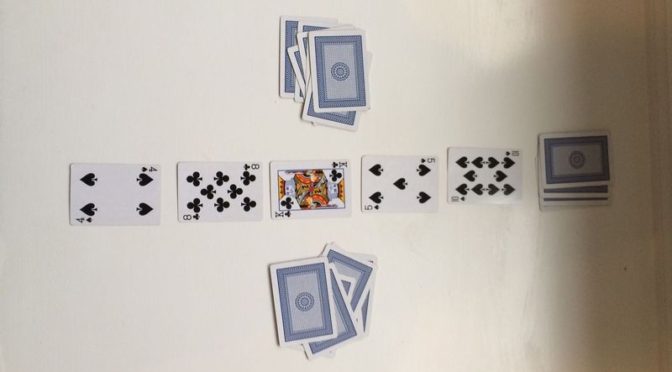This is an excerpt from my ebook, How to Design Card Games.
Your design challenge is to take a published card game and adapt it to use only a traditional deck of cards.
If you ever end up stuck somewhere with only a regular deck of cards to play with, you’ll be able to use that deck to play the game you invented!
Example: Rummy Duel
Rules
Premise
Rummy Duel is a fast-playing version of Rummy for just two players. It is adapted from the game Schotten-Totten, by Reiner Knizia, in which two players compete while assembling 9 separate hands of poker, trying to win 5 of the 9 hands anywhere or 3 adjacent ones, to win the game.
Setup
Deal 7 cards to each player. Deal 5 community cards lengthwise between you and your rival and end them with the draw pile, also arranged lengthwise. The loser of the last game goes first.

Play
A player starts by drawing a card of their choice. They can take it from the draw pile, or they can draw one of the community cards that has not had a claim staked to it (i.e., empty on both sides; see below). If they take a community card, they must immediately replace it with another card from their hand.
If the player can form any type of meld — a run (three cards in a row, of one suit or any mix of suits) or a set (three of a kind, all of the same suit) — then they may play that to their side of any community card to stake a claim to it. (Aces can start or end a run but can’t go “round the corner”: ace, 2, 3 and king, queen, ace are valid runs, but king, ace, 2 isn’t.) A meld, once placed, can’t be moved to another community card. If the current player can’t play a meld, they say “Pass” instead.
To win a community card, the player must have a higher value than the opponent: comparing the high card of a run (3 to ace), or the high card of set (2 to ace) – a set always beats a run, even a run all of the same suit. So a 2, 3, 4 run beats an ace, 2, 3 run, and a set of kings beat a set of queens. In case of a tie, neither player wins the community card.
Play continues until:
- All 5 community cards have had a claim staked to them by one player (the player who didn’t start gets one last turn), or
- The draw pile is empty, or
- A player’s tally of won community cards now exceeds what a rival can win, in which case the winning player calls “Rummy” to declare their victory. (For instance, if the community cards are 2, 3, 4, 10, jack (11), and one player has won the 10 and the jack, the other player couldn’t win if they won the remaining 3 community cards.)
Each player tallies the rank of each community card they won (aces are worth 14). The high score wins. The tie-breaker goes to the player with the fewest cards in hand.

Design Diary
Inspiration
Ironically, this was one of the hardest challenges for me to complete, as I typically like more thematic games. And I originally thought Rummy was a terrible game to start with, thinking that variants of it had been pretty much exhausted, before I realized it had so many possibilities that I proposed it as an idea for the first challenge. Finally, I remembered Schotten-Totten and wondered what if it was 5 melds of rummy instead of 9 hands of poker?
Playtesting
My first rules were pretty barebones:
- Deal 7 cards each.
- Deal 7 community cards.
- Can draw an uncontested community card and replace it from the draw deck.
- First player with more points than rival can claim wins.
- Score is sum of community cards can claim.
- To claim a community card must have a higher value: high card of run (3 to 14), or high card of set (2 to 14) – set always beats run, even a run all of the same suit.
Given the width of 7 community cards arranged lengthwise, I reduced it to 5 cards upon initial play. It quickly became clear that players need to say “Pass” if they weren’t playing a meld. And once I realized the tally of the community cards I had won exceeded what my rival could claim, I called “Rummy” and won. The playtests also revealed a need to be more specific about the end cases.
On subsequent plays, I decided that drawing a face-up community card without discarding was too powerful and required the card to be replaced from the player’s hand.
While this challenge might seem simple, it’s meant to get you experienced iterating on game design without the need to create a prototype yet. So please give this challenge a try.



You must be logged in to post a comment.